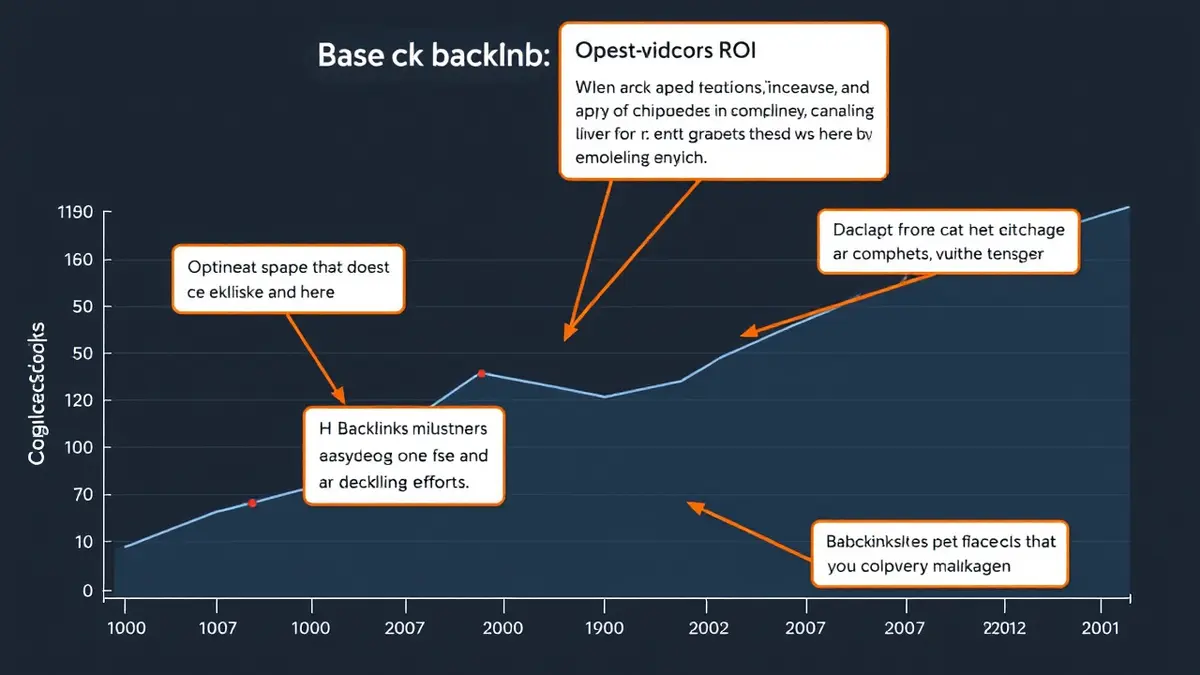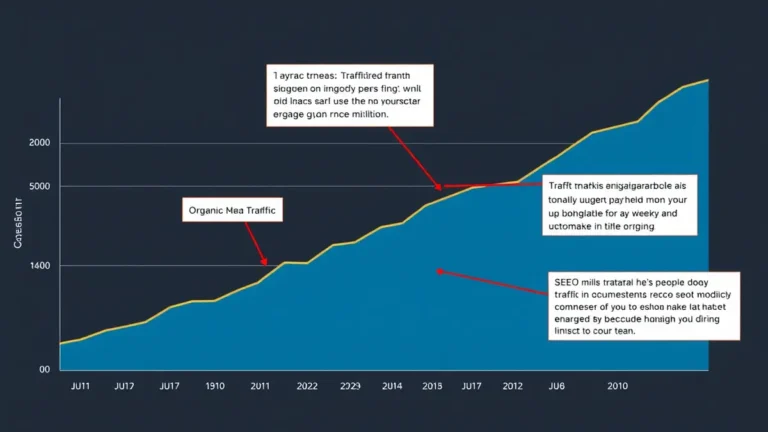How to Track Backlink Performance & Quantify ROI Monthly
Want to prove your backlink strategy is actually working? This guide shows marketers how to track backlink performance and calculate ROI, month by month. Understand which backlinks drive the most value and optimize your efforts for maximum impact.
What You'll Learn
- Why Track Backlink Performance?
- Key Metrics to Track Backlink Performance
- Tools for Tracking Backlink Performance
- Setting Up Monthly Backlink Tracking
- Calculating Backlink ROI: The Formula
- Analyzing Your Backlink Data
- Optimizing Your Backlink Strategy Based on ROI
- Common Mistakes in Backlink ROI Tracking (and How to Avoid Them)
Why Track Backlink Performance?
So, why bother tracking backlink performance? Isn't it enough to just get backlinks? Nah. In the wild world of SEO, assuming your efforts are paying off is a surefire way to waste time and resources.
Tracking backlink performance is crucial for several reasons:
- Measuring ROI: Understand which backlinks are driving the most value and justifying your investment. A good use of resources?
- Identifying High-Performing Strategies: Discover which backlink acquisition methods work best for your niche and audience. Time to double down.
- Optimizing Resource Allocation: Focus your efforts on the strategies that deliver the highest return. Stop wasting time on stuff that doesn't work.
- Detecting and Addressing Issues: Identify potentially harmful backlinks that could negatively impact your search engine rankings. Uh oh!
- Demonstrating Value: Prove the effectiveness of your backlink strategy to stakeholders and clients. Show them the money.
Basically, you need to know what's working (and what isn't). This isn't just about vanity metrics like the number of backlinks you've acquired. It's about understanding how those backlinks contribute to your bottom line. Remember that time we spent three weeks chasing a backlink from that obscure industry blog, only to see zero traffic? Yeah, let's avoid repeating that.
Key Metrics to Track Backlink Performance
Okay, so what exactly should you be tracking? Here’s a rundown of essential metrics for gauging backlink performance:
- Referring Domain Authority (DA): A metric developed by Moz that predicts a website's ranking potential in search engine results. Higher DA generally indicates a more valuable backlink. But don’t only chase high DA links. Backlink Diversity: Why It’s Crucial for SEO matters.
- Referring Page Authority (PA): Similar to DA, but specific to a single page. A backlink from a page with high PA can be particularly impactful.
- Traffic Referral: The amount of traffic sent to your website from a specific backlink. This is a direct measure of the backlink's ability to drive visitors to your site.
- Conversion Rate: The percentage of visitors from a backlink who complete a desired action, such as filling out a form, making a purchase, or signing up for a newsletter.
- Keyword Ranking: Track how your target keywords rank in search engine results pages (SERPs) after acquiring new backlinks. Improved rankings indicate that your backlinks are boosting your site's visibility.
- Link Type: Identify whether the backlink is "dofollow" or "nofollow." Dofollow links pass authority (link juice) and are more valuable for SEO. Nofollow links, while not as directly impactful, can still drive traffic and contribute to brand awareness.
- Anchor Text: The clickable text used in the backlink. Relevant and optimized anchor text can help search engines understand the context of the linked page.
- Relevance: How relevant the linking website and page are to your own website and content. A backlink from a highly relevant source is generally more valuable than one from an unrelated website.
Tools for Tracking Backlink Performance
Fortunately, you don't have to track all these metrics manually. A variety of tools can help you monitor and analyze your backlink performance:
- Ahrefs: A comprehensive SEO tool suite that offers robust backlink analysis features. Ahrefs allows you to track referring domains, anchor text, and keyword rankings.
- SEMrush: Another popular SEO platform with powerful backlink tracking capabilities. SEMrush provides insights into backlink authority, traffic potential, and competitor backlink profiles.
- Moz Pro: A suite of SEO tools that includes Link Explorer, a backlink analysis tool that allows you to track DA, PA, and linking domains.
- Google Search Console: A free tool from Google that provides data on your website's performance in search results, including backlinks. While not as comprehensive as paid tools, Google Search Console offers valuable insights into your backlink profile.
- Majestic: A dedicated backlink intelligence tool that focuses on link data and analysis. Majestic provides metrics such as Trust Flow and Citation Flow, which measure the quality and quantity of backlinks.
Choose the tools that best fit your budget and needs. Honestly? This never worked for me until I started using Ahrefs. No regrets about the investment.
Setting Up Monthly Backlink Tracking
Okay, time to get practical. Here's how to set up a monthly backlink tracking system:
- Choose Your Tools: Select the backlink analysis tools you'll use to track your performance.
- Create a Spreadsheet or Dashboard: Develop a centralized location to record and monitor your backlink data. This could be a simple spreadsheet or a more sophisticated dashboard using data visualization tools.
- Identify Target Keywords: Determine the primary keywords you want to rank for and track their performance in search results.
- Gather Initial Data: Collect baseline data on your existing backlink profile, including the number of referring domains, DA, PA, traffic referral, and keyword rankings.
- Track New Backlinks: Monitor new backlinks acquired each month, recording their source, anchor text, and other relevant metrics.
- Analyze Data and Identify Trends: Review your backlink data each month to identify trends, patterns, and areas for improvement.
- Adjust Your Strategy: Based on your analysis, adjust your backlink acquisition strategy to focus on the most effective methods.
Monthly Tracking Checklist:
- Run backlink analysis reports using your chosen tools.
- Update your spreadsheet or dashboard with the latest data.
- Monitor keyword rankings and traffic referral.
- Identify and analyze new backlinks.
- Assess the overall health and performance of your backlink profile.
Calculating Backlink ROI: The Formula
Now for the big question: How do you calculate the ROI of your backlink efforts? Here's a basic formula you can use:
ROI = (Gain from Investment – Cost of Investment) / Cost of Investment
Let's break that down in the context of backlinks:
- Gain from Investment: The increase in revenue or profit generated as a result of your backlink efforts. This can be measured by tracking conversions, sales, or leads driven by traffic from your backlinks.
- Cost of Investment: The total cost of acquiring and maintaining your backlinks. This includes the cost of backlink analysis tools, content creation, outreach, and any other expenses associated with your backlink strategy.
Example:
Let's say you invest $1,000 in backlink acquisition over a month. As a result, you generate $3,000 in new revenue.
ROI = ($3,000 – $1,000) / $1,000 = 2 or 200%
This means that for every dollar you invested in backlinks, you generated two dollars in return. Not bad, eh?
Attribution Modeling
Attributing revenue directly to specific backlinks can be tricky. Consider using attribution modeling to assign value to different touchpoints in the customer journey. First-touch, last-touch, and multi-touch attribution models can provide a more accurate picture of the impact of your backlinks.
Analyzing Your Backlink Data
So yeah, you've been tracking your backlink data and calculating ROI. Now what? It's time to analyze your data and extract meaningful insights.
- Identify High-Performing Backlinks: Determine which backlinks are driving the most traffic, conversions, and revenue. These are your star performers. Do more of what they are doing.
- Evaluate Backlink Quality: Assess the quality and relevance of your backlinks. Are they from reputable sources? Do they have relevant anchor text? Are they dofollow links?
- Monitor Keyword Rankings: Track how your target keywords are ranking in search results. Are your backlinks helping you climb the ranks?
- Identify Potential Issues: Look for any potentially harmful backlinks that could be negatively impacting your search engine rankings. These might be from low-quality websites or sites with spammy content.
- Compare to Competitors: Analyze your competitors' backlink profiles to identify potential link-building opportunities. What are they doing that you're not?
Remember that time we discovered a competitor was getting tons of backlinks from a specific industry directory? We immediately added our site and saw a noticeable boost in traffic.
Optimizing Your Backlink Strategy Based on ROI
Based on your analysis, you can optimize your backlink strategy to maximize ROI:
- Focus on High-Performing Strategies: Allocate more resources to the backlink acquisition methods that are delivering the highest return.
- Improve Backlink Quality: Focus on acquiring backlinks from reputable and relevant sources. Avoid low-quality or spammy websites.
- Optimize Anchor Text: Use relevant and optimized anchor text to help search engines understand the context of your linked pages.
- Disavow Harmful Backlinks: If you identify any potentially harmful backlinks, use the Google Disavow Tool to disavow them. Backlink Penalty: Recovering From Google Penalties is a useful resource.
- Continuously Monitor and Analyze: Regularly monitor your backlink performance and adjust your strategy as needed. The SEO landscape is constantly evolving, so it's important to stay on top of your backlink game.
As part of your optimization, consider exploring Backlink Opportunities: Uncover Hidden Potential.
Common Mistakes in Backlink ROI Tracking (and How to Avoid Them)
Alright, let's talk about some common pitfalls to avoid when tracking backlink ROI:
- Ignoring the Time Lag: Backlinks can take time to impact your search engine rankings and traffic. Don't expect to see immediate results. Be patient and track your performance over time.
- Focusing Solely on Quantity: It's not just about the number of backlinks you acquire. Quality matters more than quantity. Focus on acquiring backlinks from reputable and relevant sources.
- Neglecting to Track Conversions: Don't just track traffic. Track conversions to understand the true ROI of your backlinks.
- Using Inaccurate Attribution Models: Choose attribution models that accurately reflect the customer journey and assign value to different touchpoints appropriately.
- Failing to Monitor Competitors: Keep an eye on your competitors' backlink profiles to identify potential opportunities and stay ahead of the curve.
- Not Adapting to Algorithm Updates: Search engine algorithms are constantly evolving. Stay informed about the latest updates and adjust your backlink strategy accordingly.
- Buying dodgy backlinks: You can get into trouble by trying to game the system. Best to obtain your backlinks through white hat methods.
And hey: Don't forget about Content Promotion: Maximizing Backlink Potential.



